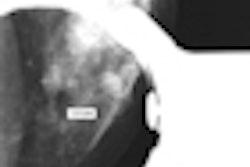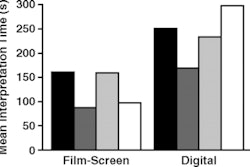Full-field digital mammography (FFDM) interpretation time is improved by about a third when digitized priors are used, according to a new study published in the June issue of the American Journal of Roentgenology.
Dr. Rachel Brem and colleagues at George Washington University Medical Center in Washington, DC, compared the time for interpretation of screening FFDM images using prior analog mammograms and also digitized prior analog exams. They found that using digitized priors improved average interpretation time by 32%.
"Regardless of the type of mammography [used for screening, whether analog or digital], comparison with prior examinations is critical and has been shown to result in the diagnosis of smaller, earlier-stage breast cancers," Brem wrote (AJR, June 2011, Vol. 196:6, pp. 1436-1438).
In the research, Brem's team included 100 screening FFDM studies that had been taken between April and May 2008. The studies were interpreted by four radiologists, two fellows, and two mammographers. All the FFDM images had comparison analog mammograms that had been obtained a least a year earlier and were digitized using a 43-µm film digitizer.
"People talk about how hard it is [to use analog priors with FFDM], but no one's ever done a study to quantify interpretation time using digitized priors and analog priors," Brem told AuntMinnie.com. "Although we expected there to be a difference in interpretation time between digitized priors and analog, that difference was greater than we thought it would be."
In a first sweep, the 100 FFDM images were interpreted using the digitized prior mammogram on two 5-megapixel monitors and PACS (the interpreting radiologists could use all available PACS tools). In a second sweep four weeks later, the same 100 screening FFDMs were interpreted using the original analog mammograms mounted on an alternator at 90° to the monitors used for the FFDMs.
"Combining all of the readings, the average time recorded for FFDM with digitized priors was 39.76 seconds, whereas the average time for analog film priors was 58.56 seconds," Brem wrote. "This provides a statistically significant difference of 18.80 seconds, and illustrates a 32% decrease in reading time when using a digitized prior analog mammogram for comparison studies as opposed to an analog film prior."
Mean reading time in seconds
|
||||||||||||||||||||||||||||||
| Data courtesy of the American Roentgen Ray Society (ARRS). |
And the interpretation time improvement occurred no matter what level of experience the reader had, Brem noted.
"Decreased time for interpretation was seen in all readers, regardless of their experience level, likely due to an increase in workflow when all imaging is viewed using the same reading conditions," she wrote.
Brem acknowledged that the study had some limitations, including that the team measured time of interpretation but not accuracy, and that it used an alternator at 90° in relation to the monitor for the analog priors -- there are other reading conditions that could be put in place for this scenario that might improve interpretation times, she wrote.



















